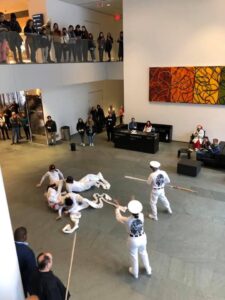A Sample of Works & Ideas
Archives
"Dressing Up For Civil Rights" MOMA performance, November 2019






Toddler Trump 2017-2018






Painted Yellow Submarine Propane Tank, Chimayo, NM 2019
Rules for Dancing with trauma
text by eric anthamatten-dominguez
Morse Covid
Full Experience (filmed by Mark Pirtle)
Granny's tamales
Catalina Woods makes 500 tamales at a time. This is footage from a session with mi abuelita where she teaches me how to make tamales while telling me stories from her life.
Black Monuments Matter
A walk around New York City shows all of the beautiful monuments to the Black American experience.
Music & Poetry Tracks


Language and Children
Eric wrote this when he was a Tribeca.
(This is why he deserves the title of Master A.)
Language and Children
Yesterday, a young student (7 years old) called me aside after class, "I need to talk to you." The conversation went something like this:
"I was at dance class today, and the teacher said that we all looked like crap." [He hesitated a bit before he said "crap," as it was obviously a bad word for him]
"Did that upset you?"
"Yes."
"Did he say it to help you get better or just to be mean?"
"I don't know."
"Did you tell him that it upset you."
"He said we couldn't raise our hands during class."
"Maybe you should tell him after class that it upset you."
I then went on to try to mentor the student by telling him how sometimes teachers use harsh words and critique as a way to make you get better, as well as some metaphor about how crap becomes fertilizer becomes flowers...blah, blah, blah...
I share this story only to emphasize this: our words matter.
As teachers, we are given a most precious and precarious responsibility. We have much power and influence on the hearts and minds of our students, so we must not only be vigilant about the quality of our instruction, but also the care of our words. Each teacher has their own personality, and the last thing that we want to do is become cookie-cutter, one-dimensional automatons simply going through the motions, something not only detrimental to teacher and student, but bad for business. That being said, we must be very careful not to impose our personal quirks, especially our deployment of language (humor, sarcasm, critique), on our students in a way that fosters negativity or self-loathing. What seems to us a benign comment in passing can upset a child for an entire day and change their whole relationship to a practice in ways that are sometimes irrevocable. This is especially the case for our Tiny/Little Champs, as well as our beginners. Referring to their work as "crap," making "fail buzzer" sounds, or reprimanding in a way that simply demeans and does not "build up" is irresponsible and a most egregious abuse of the power of our positions as role models. We are not only in the "business" of teaching martial arts. We are also in the "business" of communication. The root of the word communication is communitas, which means "to bring together." It also gives us our words "community" and "communion." Communication is that which makes community possible thus fostering communion. The opposite of community is division, monologue, narcissism, and, in the end, destruction. Words are the screws that hold together the house. They can also be the termites that eat away at it from the inside.
Indeed, we don't want to coddle the students, as that can be just as dangerous. (Here's a great article from the NY Times on that matter: "Losing is Good for You," http://www.nytimes.com/
|
LOS ANGELES — AS children return to school this fall and sign up for a new year’s worth of extracurricular activities, parents should keep one question ...
|
1. Use "positive" language: "Positive" language is not simply praise. "Positive" language means minimizing or eliminating negations (words like "no," "not," etc.) One must critique and correct "positively," which is to say, instead of saying, "Don't drop your hands!" or "You're not bending your knee when you kick!" say, "Keep your guards up," or "Bend your knee when you kick." Something as simple as this changes the valence of the critique into something that not only is more positive, but more likely to be listened to.
2. P-C-P (Praise Correct Praise): Sometimes called the "sandwich" approach (bread, meat, bread), when engaging in more involved critiques, begin with something positive before blasting them with all the things they did wrong. This approach does have its potential problems (as articulated in the above article), but it is a good general rule to follow, especially when dealing with children. It also means that they are more likely to listen when the conversation begins with a "Yes!" instead of a "No!"
3. Not all language is verbal: As teachers, we are always on display. This is exhausting at times, but it means that we need to be all the more aware of the way our body communicates messages to the students. Children are especially good at reading faces. Don't we all have memories of our father or mother looking at us in a certain way only to leave us melted in a puddle of our own shame? A simple glance of the eye can be the greatest reward or a painful punishment. This does not mean we always have to be in radiant smile mode (which would not only be impossible, but kind of freaky), and shame is often an important element of learning, but we must be aware that our non-verbal cues are just as powerful, if not moreso. Concomitant with this is attention: ignoring a student is just as detrimental as squashing them with words. In certain large classes, a student can get lost in the cacophony and chaos. We must acknowledge them at least once in the class lest they feel themselves to be an unimportant shadow.
4. Dialogue not monologue: This can be tricky, as many of us have been trained, both as martial artists and products of our education system in general, to think that instruction is a passive reception of information from some master. There are certainly times when this is necessary, i.e., to simply trust the authority and say, "Yes mam!," no questions asked. But we must also do what we can to make the student ACTIVE in her learning process, to become a co-participant in a dialogue. One way to do this is to ask the individual or the class a question instead of giving them the ready-made answer. "What do you think you did good?" followed by, "What parts do you feel you don't know or need to get better?" This way, the student takes charges of their own education, and develops skills of self-critique. The teacher, in this capacity, becomes less of an external and arbitrary authority and more of a facilitator and midwife helping to "birth" knowledge instead of cram it down the student's throat.
5. Students are individuals: Each child has their own various sensitivities. Language that might work with one student may not work with another. In the same way the student is attuned to our language, both verbal and non-verbal, so too must we be attuned to theirs. This is difficult sometimes given the pace and size of class, but we must take the time to notice of a student's attitude changes and try our best to figure out a way of communicating that critiques (but does not coddle), but also keeps the student engaged and enthusiastic. We cannot come to class with some abstract ideal of how a student should behave or look. This is not to say that "anything goes," as we must, as responsible teachers, set standards and have ideals towards which we strive. But if our "ideals" are in no way connected to the complex and multi-dimensional psychic and physical life of the child, then we cultivate and environment that oppresses their individuality, their creativity, their uniqueness, and, ultimately, their freedom. We must guide the child, not "shape" them into some pre-existing mold. We shape things, not people.
6. Humility, humility, humility: Authority and humility are not antonyms. One can have confidence and be "an authority" on some matter while at the same time have the humility to know that they themselves, as teachers, are always in a situation of dialogue, listening, learning, and growth. Often, the best "authorities" are the one's constantly asking questions about their authority and the most willing to say, "Well, maybe I can think about this in another way." Humility is connected with patience. I learn something from students and co-workers all the time, if not about martial arts, then about human beings and myself as such. If we are really in the "business" of teaching, we must understand that the joy of learning begins and ends with curiosity and wonder, which is to say, education begins and ends with the question, not the answer.
7. Trust: Communication and education is impossible without trust. The student must trust us, absolutely. If the students and their families simply came to learn punches and kicks, then the "business" would have failed long ago. We are members of a community. We have the great honor of participating in the rearing of a child. Anything that fosters distrust (gossip, hurtful language, deceit) violates this duty. "It takes a village to raise a child." The shadow of this fact: It takes one parasite to destroy an entire village.







